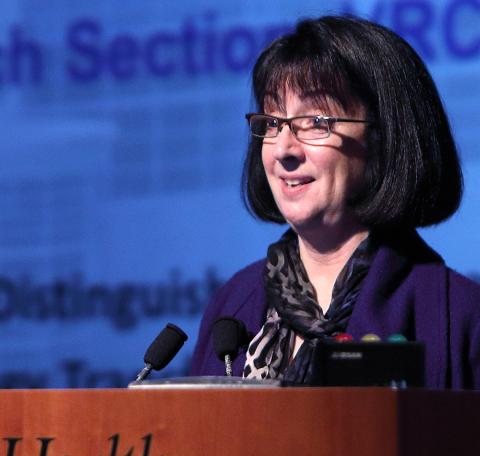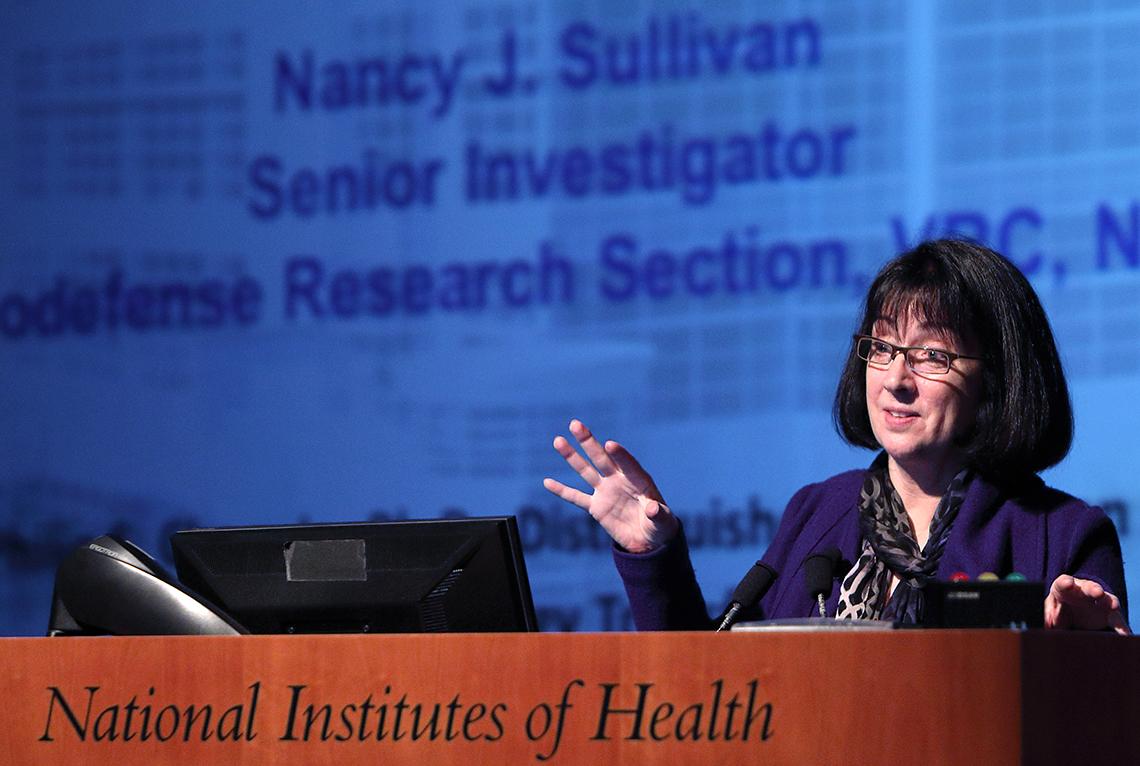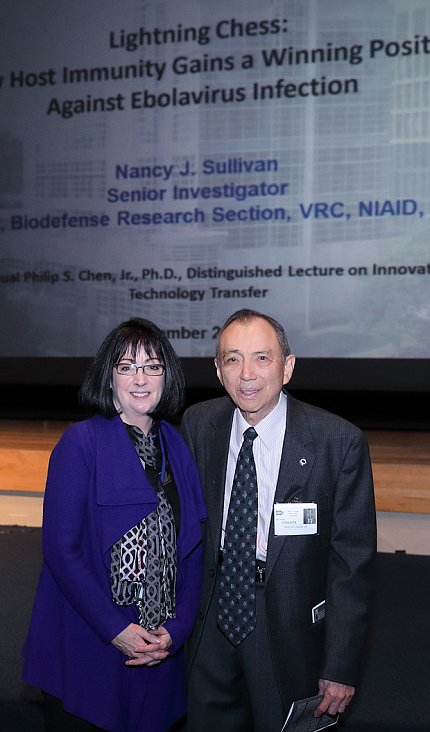Chasing Virus Checkmate
Sullivan Describes Long-Range Science Match vs. Ebola

Photo: Chia-Chi Charlie Chang
“I like to think of it like lightning chess,” Sullivan said, “because the host and the virus—almost irrespective of whatever the virus is—have this interplay where whatever the virus does, the host tries to quell that and then the virus in turn evolves to evade whatever the host is doing to clear the virus. With Ebola, that process is very quick because once there are symptoms observed, subjects can either resolve or suffer the fatal effects within a week or two. So, it really is a very fast process of this battle between the virus and the host.”
An NIAID senior investigator in the NIH Vaccine Research Center and chief of the biodefense research section, Sullivan recently delivered “Lightning Chess: How Host Immunity Gains a Winning Position Against Ebola Virus Infection,” the 13th annual Philip S. Chen Distinguished Lecture on Innovation and Technology Transfer.
The talk honors longtime scientist, research administrator and overall visionary leader Chen, who retired from the NIH Office of Intramural Research in 2006 after a 41-year career here.
Known as the scientist who invented a phosphate assay technique still used in labs today, Chen the administrator established the Office of Technology Transfer at NIH, formulated all of its guiding principles and created the CRADA, or cooperative research and development agreement. Once implemented, his vision opened whole new avenues of research invention, creativity and partnership for investigators at NIH working with like-minded scientists outside the agency.
“Phil was well known for making things better…he made the intramural research program a well-oiled machine,” said NIH deputy director for intramural research Dr. Michael Gottesman, who introduced the lecture and recognized the honoree, who has attended the event every year and sat in the front row with his wife and family.
In her lecture, Sullivan discussed her group’s “two main projects at the VRC—the vaccine and the antibody work.” She began, though, by acknowledging individuals in NIAID’s Technology Transfer and Intellectual Property Office.
“They labor silently behind the scenes and don’t get the recognition that the scientists get and we really rely on them so heavily,” Sullivan said. “They work so hard for us to fulfill the NIH mission of getting these discoveries that we make into people who can benefit from them…You might think they step in at the end after we’ve made discoveries and done clinical developments, but in fact they’re integrally involved from the very beginning. They help us with research collaboration agreements, with patent filing and, of course, CRADAs.”

Photo: Chia-Chi Charlie Chang
Sullivan described a typical viral infection chess game. A virus makes the opening move, invading and replicating locally at the site of infection. The host then sends out an innate signal to the immune system, alerting it to the danger. The immune system answers the call on two fronts: A humoral response circulates throughout other tissues, recruiting antibodies to capture the virus; a cellular response engages—shortly before or just after—to mop up whatever the humoral misses.
“What happens ultimately is if the virus wins this battle of lightning chess, then it’s checkmate and we know in Ebola infections that about 50 percent of the people who are infected actually succumb to the lethal effects of the virus,” Sullivan explained. “In contrast, if the host can mount its responses early enough and with enough strength, then virus replication is controlled and the host wins that battle. We want to understand the interplay of these factors and try to use vaccines and immunotherapies to give the host an advantage in this game.”
Seeking to better equip hosts, Sullivan and her team study prevention—gene-based Ebola vaccines—and treatment—a monoclonal antibody called mAb114 immunotherapy. Their research also helps further define the mechanisms and strategies at work in the game, so that future vaccines and immunotherapies are more informed for upcoming battles.
Ebola is a tough, persistent opponent, Sullivan said. The earliest experiments with vaccines disappointed scientists; traditional approaches led instead to enhanced disease in animal tests.
“When we began this work, the field was thinking that perhaps this Ebola virus was just too aggressive, too fast and too potent to protect against with a vaccine,” she admitted. “We, on the other hand, wondered whether filoviruses had evolved mechanisms to evade humoral immunity and maybe we’d need other components of the immune response to clear the virus more effectively.”

Photo: Chia-Chi Charlie Chang
Looking at pathogen structure and replication, investigators learned several unique characteristics of the virus. Unlike HIV, for instance, Ebola does not have frequent sequence changes.
“If you compare the glycoprotein sequence from 1976 to the current outbreak, they’re virtually identical,” Sullivan said.
The problem with Ebola is that the virus folds and curls onto itself, making it hard for antibodies to reach, latch onto and vanquish infected cells. Also, the virus reproduces in large volumes, so the antibody army must be equally robust to overcome Ebola’s structure.
In addition, unlike other viruses, Ebola doesn’t just choose one type of tissue to infect. It enters the lymph nodes, but then very quickly moves to liver and spleen, circulating to kidneys, lungs and brain.
“Realizing the replication strategy helps us think about how we might approach a vaccine,” Sullivan noted. “Our goal when we started with vaccine development was to induce both humoral and cellular immunity, thinking that humoral immunity would not be sufficient.”
Sullivan’s next quest was to consider how to advance the candidate vaccine in humans via clinical trial.
“It’s very difficult for Ebola” for several reasons, she said. Ebola virus outbreaks are sporadic; nearly 20 years separated a 1976 outbreak from the next in 1994. In recent times, infection periods have occurred more frequently: 2014-2016, 2017 and 2018. However, epidemic sites have been geographically distant from each other, even within the same country.
“Even though we see the Democratic Republic of Congo [DRC] has experienced repeated outbreaks, it’s a huge country,” Sullivan said. “Just the capital alone has 12 million people, so it’s difficult to know who you would vaccinate if you wanted to do a randomized control trial. But, more importantly, with lethal pathogens like Ebola virus, it’s hard to argue for placebo-controlled trials.”
Ultimately, Sullivan’s vaccine and several others were developed, mass-produced and dispensed widely. But for a number of reasons, including regional political instability, the current high-risk Ebola epidemic in DRC was not yet contained at the time of Sullivan’s lecture.
“It illustrates the continued urgency for therapeutics even if we have vaccines,” she emphasized, “because in spite of having [more than 25,000 people vaccinated] we’re still having trouble controlling this outbreak.”
Sullivan also described her team’s work on developing treatments for Ebola infection. Watch the full lecture at https://videocast.nih.gov/summary.asp?Live=28496&bhcp=1.
